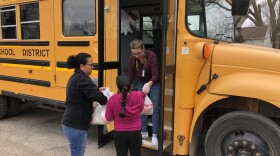Schools are resuming instruction but with the COVID-19 pandemic continuing, they are facing an ever-changing metric for whether students are physically in school buildings. Being able to provide meals to them no matter how they’re learning remains a challenging priority.
This week the U.S. Department of Agriculture announced it’s extending provisions that allow schools to provide free meals to all children, which can be packaged for pick-up, delivered to classrooms or served in a traditional lunch line.
USDA made these adjustments in the spring to account for the abrupt closure of schools, and the School Nutrition Association worked with Congressional allies during the summer to push for continuation into the 2020-2021 school year.
Diane Pratt-Heavner, a spokeswoman for the School Nutrition Association, says until the announcement, schools had to assume they would be expected to abide by the pre-pandemic regulations.
“They were having to figure out, how do we verify enrollment and eligibility and collect payment on the curbside or in the classroom?” she said, “and how do we do it safely?”
For example, schools didn’t want all kids touching the same PIN pad during the pandemic, which was a typical way to confirm enrollment and eligibility.
Lunchtime Solutions is a private company that contracts with districts in Iowa, Nebraska, Missouri, Minnesota and South Dakota to provide school food service. Heather Wahl, compliance coordinator, says the extension will help schools meet student needs regardless of whether learning is in person or online. The requirement that meals be served to groups is waived and one parent can pick up a set of meals for the whole family.

“It’s very helpful that the kids don’t have to go out there,” Wahl says, “and one parent can pick up for all the children.”
Wahl says in anticipation of this unusual school year, Lunchtime Solutions invested a lot of time this summer planning for menus that could easily pivot from one setting to another. Every menu includes an option that could be packaged up to-go so that on a day’s notice a school would be able to switch if instruction moves from in-person to remote.
The demand for to-go packaging has been a bit of a challenge during the spring and summer, says Deni Winter, also of Lunchtime Solutions, with many restaurants as well as school and summer meals sites using more than usual. She says meals served in schools will continue to use plastic lunch trays that can be washed and sanitized. Meals being delivered to classrooms, to reduce the size of student gatherings in the lunchroom, may sometimes need to use a disposable container for certain items but she’s hopeful those can primarily be reserved for meals handed out for pick-up.
Wahl says regardless of the delivery method, every meal will meet federal requirements such as including vegetables, fruit and choice of milk. But students in the lunchroom will notice they are no longer able to serve themselves or go back for seconds. Still, Wahl says there should always be plenty of choice and the company’s menus emphasize the meals the students have typically liked best, such as chicken nuggets, pepperoni pizza bake and cheeseburgers.
Pratt-Heavner says schools will still enroll eligible students in the free and reduced-price meal programs this fall because the changes are only approved through December 31. They’ll need to be prepared to return to the standard regulations come January, though the SNA is continuing to seek an extension through the spring term.



